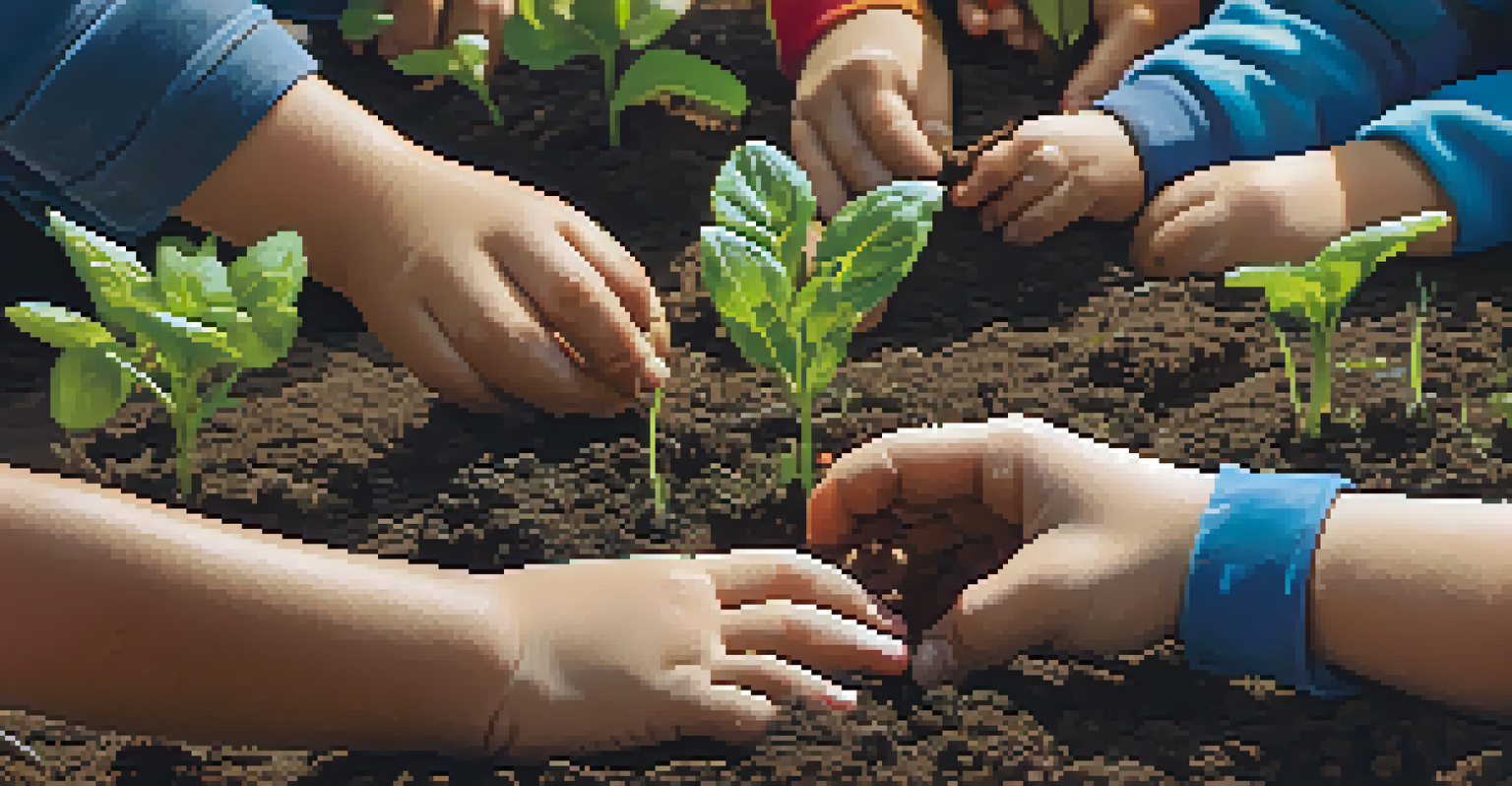Outdoor Learning: Inspiring Future Environmental Stewards

The Importance of Outdoor Learning for Children
Outdoor learning is essential for children's development, offering them unique experiences that the classroom cannot provide. When kids step outside, they engage with nature, leading to a deeper understanding of the environment. This connection can spark curiosity and encourage critical thinking about ecological issues.
The best classroom and the richest cupboard are roofed only by the sky.
Studies have shown that outdoor experiences enhance physical health, boost mental well-being, and improve social skills. For instance, a day spent exploring a forest can lead to increased creativity and problem-solving abilities. These activities also foster teamwork as children collaborate on projects, like building shelters or identifying plants.
Moreover, outdoor learning instills a sense of responsibility towards the environment. As children learn about ecosystems and wildlife, they become more conscious of their actions and the impact they have on the planet. This early exposure lays the foundation for lifelong stewardship.
Connecting Outdoor Learning to Environmental Stewardship
Environmental stewardship is about taking care of our planet for future generations, and outdoor learning plays a crucial role in this. When children explore nature, they develop a personal connection that motivates them to act responsibly. For example, a child who plants a tree may feel a sense of ownership and commitment to its growth.

Experiential learning, like nature walks or gardening, allows kids to witness the consequences of their choices firsthand. They can see how litter affects wildlife or how pollution impacts water sources, making abstract concepts tangible. This real-world learning encourages action, whether it’s participating in clean-up events or advocating for sustainable practices.
Outdoor Learning Enhances Development
Engaging with nature boosts children's creativity, problem-solving skills, and social abilities.
In essence, outdoor learning transforms passive knowledge into active engagement. When children see themselves as part of nature, they are more likely to become advocates for environmental causes, making informed decisions that benefit the planet.
Creating Effective Outdoor Learning Programs
Designing outdoor learning programs requires careful planning to ensure they are engaging and educational. Start with clear objectives that align with environmental education goals, such as fostering a connection to nature or understanding local ecosystems. Including hands-on activities, like nature scavenger hunts, can make learning fun and memorable.
In every walk with nature, one receives far more than he seeks.
Collaboration with local environmental organizations can enhance program offerings. These partnerships often bring in experts who can share valuable insights and resources, enriching the experience for participants. Additionally, involving the community in these programs fosters a sense of shared responsibility for the environment.
Finally, flexibility is key in outdoor education. Nature is unpredictable, and being open to adapting activities based on weather or participant interest can lead to unexpected learning opportunities. Emphasizing exploration and discovery helps children develop a love for the outdoors.
The Role of Educators in Outdoor Learning
Educators play a vital role in facilitating outdoor learning experiences. They are not just instructors but guides who encourage exploration and inquiry. By fostering a supportive environment, teachers can help students feel comfortable asking questions and making observations about their surroundings.
Training for educators is essential to ensure they are equipped with the knowledge and skills needed for effective outdoor teaching. This includes understanding safety protocols, environmental science, and how to engage students in meaningful discussions about nature. Professional development opportunities can also inspire educators to innovate their teaching methods.
Fosters Environmental Stewardship
Experiential learning in nature encourages children to care for the environment and adopt responsible behaviors.
Furthermore, educators should model environmental stewardship themselves. When students see their teachers actively caring for the environment, such as participating in recycling initiatives or conservation projects, they are more likely to adopt similar behaviors. Leading by example is one of the most powerful teaching tools.
Incorporating Technology in Outdoor Learning
In today's digital age, technology can enhance outdoor learning experiences. Using apps for identifying plants and animals or mapping trails can make exploration more interactive and informative. This combination of technology and nature encourages children to engage with their environment in new ways.
Moreover, technology can facilitate documentation and reflection. Students can take photos, create videos, or write blogs about their outdoor experiences, helping them articulate their learning. This not only reinforces their understanding but also allows them to share their insights with a broader audience.
However, it's important to strike a balance between technology use and genuine outdoor engagement. While devices can enrich the learning experience, they should not distract from the beauty and lessons that nature provides. Encouraging mindful use of technology ensures that children remain connected to the environment.
Challenges in Implementing Outdoor Learning
While outdoor learning is beneficial, there are challenges in its implementation. Weather conditions can be unpredictable, limiting opportunities for outdoor activities. Educators must be prepared with alternative plans and indoor activities that still promote environmental education.
Safety is another concern that educators face when taking children outdoors. Ensuring that students understand safety protocols, such as staying within designated areas or recognizing hazardous plants, is crucial. Proper training and risk assessment can help mitigate these concerns and create a safe learning environment.
Challenges in Outdoor Education
Implementing outdoor learning faces hurdles like weather unpredictability, safety concerns, and access to green spaces.
Additionally, logistical issues, such as transportation and access to green spaces, can hinder outdoor learning initiatives. Schools in urban areas may lack nearby parks or natural settings. Collaborating with local organizations or utilizing virtual field trips can help bridge these gaps and provide valuable experiences.
The Long-Term Impact of Outdoor Learning
The benefits of outdoor learning extend far beyond childhood. Research indicates that children who engage in outdoor education are more likely to develop a strong sense of environmental responsibility as adults. This connection to nature often translates into sustainable lifestyle choices, such as recycling, conserving energy, and supporting eco-friendly products.
Moreover, outdoor learning fosters critical thinking and problem-solving skills that are essential in the workforce. As students learn to navigate challenges in nature, they build resilience and adaptability—traits that are invaluable in any career. These experiences prepare them to tackle future environmental issues with creativity and determination.

Ultimately, investing in outdoor learning today is an investment in the future of our planet. By nurturing the next generation of environmental stewards, we can cultivate a society that values and protects our natural resources. The more children learn about and appreciate the environment, the brighter our future will be.